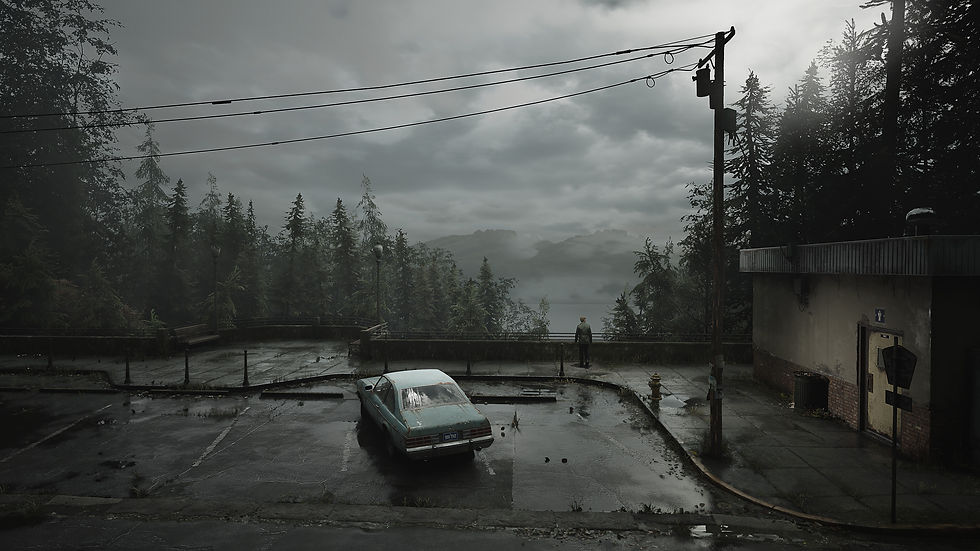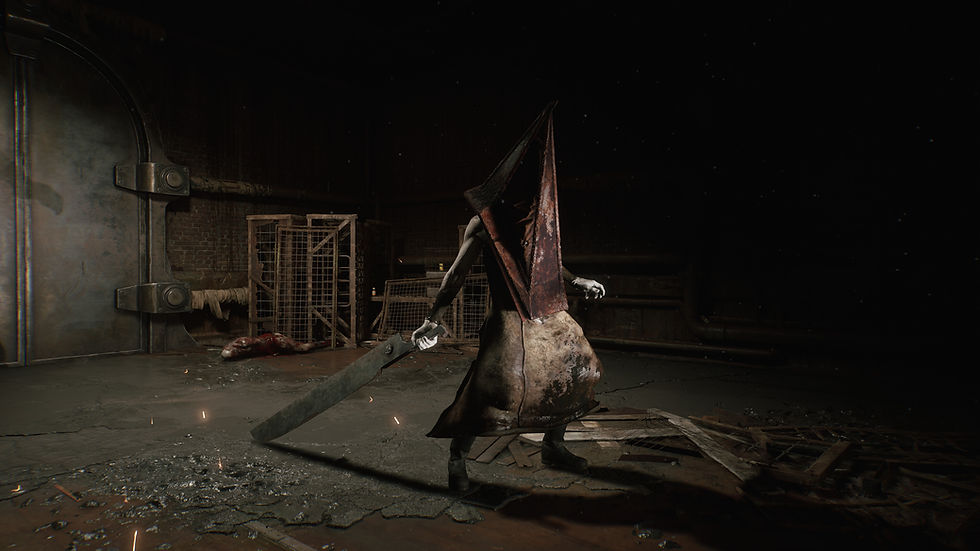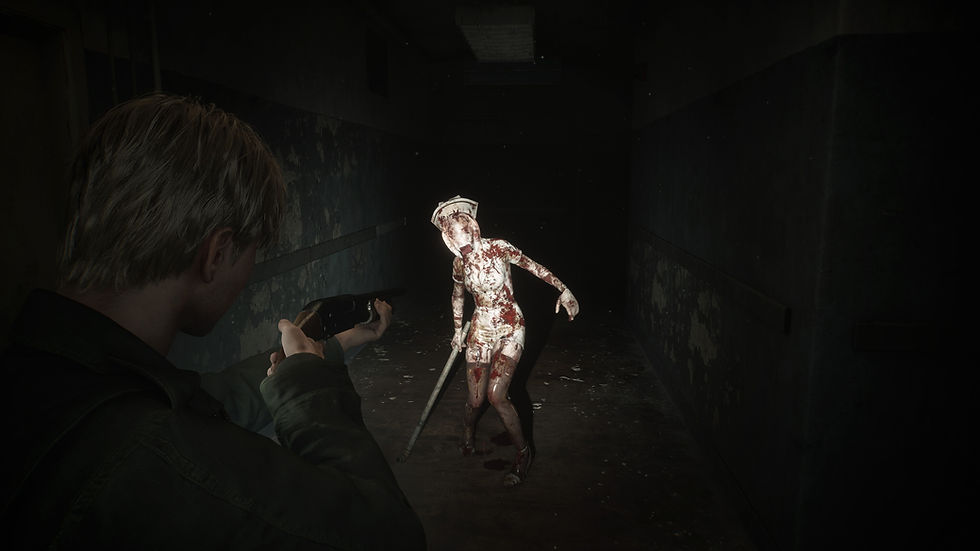Silent Hill 2’s Enduring Horror Is Still About You
- Kelly Gowe
- May 14
- 5 min read
Trigger Warning: This article discusses themes of mental illness, suicide, abuse, trauma, grief, and self-harm asdepicted in Silent Hill 2. Reader discretion is advised.
Very few games dive into guilt, repression, and trauma the way Silent Hill 2 does. More than two decades after its release, it remains one of the most emotionally layered and psychologically daring entries in video game history. It is not just the monsters or the atmosphere that make it stand out. It is the way the game turns its mechanics into mirrors and its story into self-examination.
At the center of it all is James Sunderland, a man who receives a letter from his dead wife. She says she is waiting for him in Silent Hill. That single message sets off a journey that is not about finding someone lost, but about confronting a truth buried too deep to face. As James moves through Silent Hill, the town reveals his pain back to him, piece by piece.

Silent Hill 2 does not scare you in a traditional way. It confronts you. Every item you pick up, every monster you fight, and every ending you unlock is shaped by your behavior. The game watches how you play. That is part of what makes it so unsettling.
Maria is one of the first clues that something is deeply wrong. She looks just like Mary, James’s late wife, but her personality is wildly different. She is flirtatious, bold, emotionally intense. She embodies James’s guilt and longing, all dressed up in denial. How you treat Maria throughout the game affects which ending you get. Spend too much time with her, check on her often, show too much care, and the game assumes James is choosing comfort over truth. The “Maria” ending sees him leave with her, having avoided the pain of what really happened.
Other choices are just as subtle and just as powerful. If you inspect Angela’s knife, a symbol of trauma and suicidal thoughts, the game notes it. If you check Mary’s photo or letter frequently, the game notices your attachment. If you let James’s health drop and do not heal him, it interprets that too. All of these quiet actions form a psychological profile, one the game uses to decide which ending makes sense for your James. And none of it is obvious.
There is no branching dialogue tree. No glowing red or blue choice to signal right or wrong. The game does not tell you what it is tracking. You just play. And then, when it ends, you realize the story shaped itself around you.
That is where the real genius of Silent Hill 2 begins to show. The horror is not just in the environments or the monsters. It is in the way the town reflects James’s mental state. The creatures he encounters are not random. They are versions of his guilt, his shame, and his confusion.
Pyramid Head is the clearest example. A hulking figure with a faceless mask and massive blade, he is always just behind you. Watching. Waiting. He is violent, relentless, and deeply symbolic.

He punishes not just James, but the other monsters, carrying out a twisted form of justice. Pyramid Head exists because James created him. Not literally, but psychologically. He is not a traditional boss. He is a reflection of James’s need to be judged and punished for what he did.
The Nurses are sexualized and broken, moving with erratic violence. They represent James’s conflicted feelings about Mary’s illness, about the intimacy they lost, and about his own guilt. The Lying Figures are bound in something like a straitjacket made of skin. They move in pain, unable to speak. They reflect both Mary’s suffering and James’s repression. Mannequins, composed of duplicate female limbs, suggest discomfort with sexuality and the objectification of women.
Each monster is connected to James’s inner world.

The deeper you go into Silent Hill, the worse the monsters become. They get more aggressive. More disturbing. The town evolves as James’s guilt surfaces. It is not just a location. It is a mirror. That is why every hallway and every fog-covered street feels different the second time through. You are not just progressing. You are unraveling.
Even the environments carry emotional weight. Angela, one of the other major characters, sees the town in flames. For her, Silent Hill is burning. That is the shape her trauma takes. James sees it shrouded in fog and decay. Cold. Still. Stuck. Laura, a child who knew Mary before she died, sees no monsters at all. Because she carries no guilt.
Silent Hill is not one town. It is many. It is whatever you bring into it.
The supporting cast in Silent Hill 2 tells just as much of a story as James. Angela is fragile and angry. She carries the weight of years of abuse and does not believe she is worth saving. Her journey is one of the most emotionally difficult to witness. When she walks into a staircase engulfed in fire, she says simply, “This is what it’s like for me.” And she disappears.
Eddie plays like comic relief at first, but he quickly turns dark. His inability to take responsibility for his actions becomes dangerous. He represents denial and deflection, twisted into violence. Laura is the one character who offers peace. Her lack of guilt makes her immune to the horrors of the town. She is there as a reminder. Not everyone who enters Silent Hill is condemned. Only those who carry something they have not faced.
That sense of judgment is baked into every part of the game. You are not just moving through a horror story. You are being watched. Evaluated. Shaped. And it never tells you that is happening. Which is why, when it ends, it hits differently. Because the outcome feels like your fault.
The recently released remake brings that experience to a new generation. With updated visuals and refined mechanics, it captures the atmosphere with modern fidelity while holding onto the psychological core. Some fans worried about changes to gameplay or tone, but early impressions suggest that the emotional weight is still intact.
And Silent Hill 2’s legacy continues beyond just the remake. Indie horror games like Mouthwashing pull from its stripped-down structure and focus on emotional discomfort. Narrative-heavy titles like Detroit Become Human explore choice and consequence, putting players in complex moral situations. Even games like What Remains of Edith Finch or SOMA carry echoes of Silent Hill 2’s DNA. They are not trying to scare you in the traditional sense. They want you to feel uncertain. Guilty. Complicit.
What makes Silent Hill 2 stand out is its refusal to comfort the player. It does not care if you get a happy ending. It does not care if you feel good about your choices. It wants you to sit in the aftermath. To ask questions. To look at yourself.
In today’s world of achievement systems and instant gratification, that still feels radical. A horror game that wants you to think more than it wants you to scream. A game that punishes carelessness not with a game over screen, but with an ending you cannot quite explain away.
That is why Silent Hill 2 remains a masterpiece. It holds up a mirror. And it does not blink. It asks what you are carrying. What you are hiding. What you regret. And it tells you that the only way out is through.
You do not just play it. You live with it.
And that is what keeps it haunting, even now.






